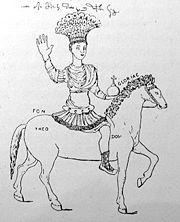
Toupha
Encyclopedia

One of the most famous touphas is that which surmounted the crown or helmet of the equestrian statue of Justinian I
Justinian I
Justinian I ; , ; 483– 13 or 14 November 565), commonly known as Justinian the Great, was Byzantine Emperor from 527 to 565. During his reign, Justinian sought to revive the Empire's greatness and reconquer the lost western half of the classical Roman Empire.One of the most important figures of...
on the column
Column of Justinian
The Column of Justinian was a Roman triumphal column erected in Constantinople by the Byzantine emperor Justinian I in honour of his victories in 543...
raised by that emperor in the Augustaion
Augustaion
The Augustaion or, in Latin, Augustaeum, was an important ceremonial square in ancient and medieval Constantinople , roughly corresponding to the modern Aya Sofya Meydanı...
square in Constantinople
Constantinople
Constantinople was the capital of the Roman, Eastern Roman, Byzantine, Latin, and Ottoman Empires. Throughout most of the Middle Ages, Constantinople was Europe's largest and wealthiest city.-Names:...
. It is known from a drawing of it made in the 15th century. Particularly imposing in size, it fell from the statue in the 9th century and was put back on by some dangerous acrobatics – a rope was stretched between the roof of Hagia Sophia
Hagia Sophia
Hagia Sophia is a former Orthodox patriarchal basilica, later a mosque, and now a museum in Istanbul, Turkey...
and the summit of the column by means of an arrow along which someone could tightrope-walk to the statue. The emperor Theophilus rewarded the tightrope-walker with 100 gold nomisma
Nomisma
Nomisma was the ancient Greek word for "money" and is derived from nomos "anything assigned, a usage, custom, law, ordinance"....
ta for this exploit.
In colloquial language, toupha or typha came to mean a "tiara
Tiara
A tiara is a form of crown. There are two possible types of crown that this word can refer to.Traditionally, the word "tiara" refers to a high crown, often with the shape of a cylinder narrowed at its top, made of fabric or leather, and richly ornamented. It was used by the kings and emperors of...
", and the 12-century historian, Joannes Zonaras
Joannes Zonaras
Ioannes Zonaras was a Byzantine chronicler and theologian, who lived at Constantinople.Under Emperor Alexios I Komnenos he held the offices of head justice and private secretary to the emperor, but after Alexios' death, he retired to the monastery of St Glykeria, where he spent the rest of his...
, even records that a verb, typhoomai ("to be filled with extreme arrogance"), was derived from it.

